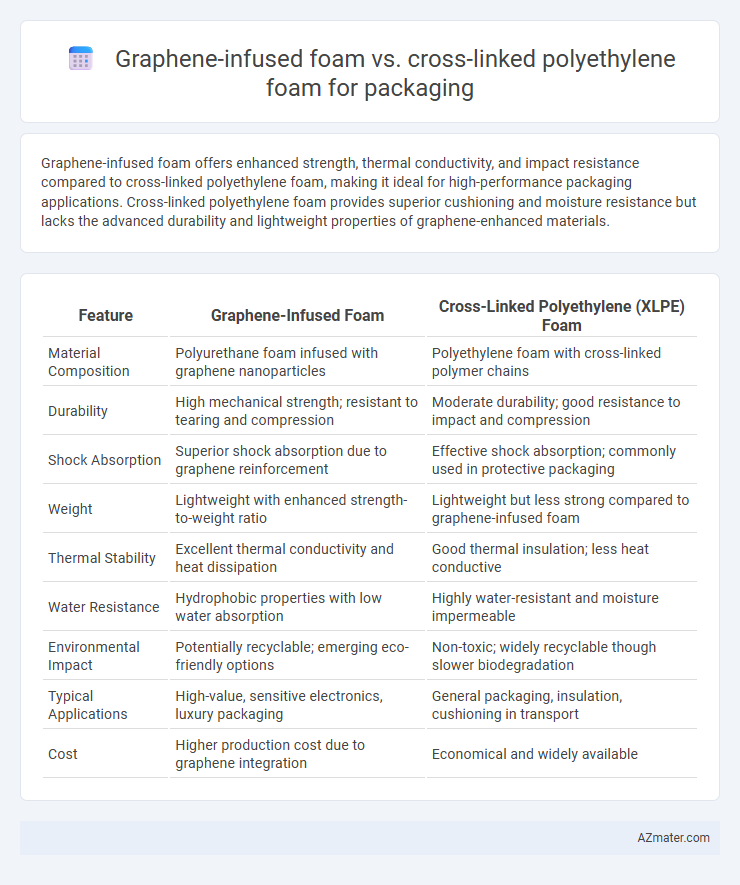Graphene-infused foam offers enhanced strength, thermal conductivity, and impact resistance compared to cross-linked polyethylene foam, making it ideal for high-performance packaging applications. Cross-linked polyethylene foam provides superior cushioning and moisture resistance but lacks the advanced durability and lightweight properties of graphene-enhanced materials.
Table of Comparison
| Feature | Graphene-Infused Foam | Cross-Linked Polyethylene (XLPE) Foam |
|---|---|---|
| Material Composition | Polyurethane foam infused with graphene nanoparticles | Polyethylene foam with cross-linked polymer chains |
| Durability | High mechanical strength; resistant to tearing and compression | Moderate durability; good resistance to impact and compression |
| Shock Absorption | Superior shock absorption due to graphene reinforcement | Effective shock absorption; commonly used in protective packaging |
| Weight | Lightweight with enhanced strength-to-weight ratio | Lightweight but less strong compared to graphene-infused foam |
| Thermal Stability | Excellent thermal conductivity and heat dissipation | Good thermal insulation; less heat conductive |
| Water Resistance | Hydrophobic properties with low water absorption | Highly water-resistant and moisture impermeable |
| Environmental Impact | Potentially recyclable; emerging eco-friendly options | Non-toxic; widely recyclable though slower biodegradation |
| Typical Applications | High-value, sensitive electronics, luxury packaging | General packaging, insulation, cushioning in transport |
| Cost | Higher production cost due to graphene integration | Economical and widely available |
Introduction to Advanced Packaging Foams
Graphene-infused foam offers enhanced tensile strength, thermal conductivity, and electrical shielding compared to traditional cross-linked polyethylene (XLPE) foam, making it ideal for protecting sensitive electronics during shipping. Cross-linked polyethylene foam remains widely used due to its excellent cushioning, chemical resistance, and cost-effectiveness in packaging applications. Emerging graphene integration provides superior durability and energy absorption, positioning it as a next-generation material for advanced packaging solutions.
Understanding Graphene-Infused Foam
Graphene-infused foam enhances traditional packaging materials by integrating graphene's exceptional strength, flexibility, and thermal conductivity, resulting in superior impact resistance and durability compared to standard foams. Its lightweight structure combined with excellent cushioning properties effectively protects fragile items during shipping while offering improved environmental resistance. This innovation surpasses cross-linked polyethylene foam by providing enhanced mechanical performance and longer lifespan under varied packaging conditions.
Properties and Structure of Cross-Linked Polyethylene (XLPE) Foam
Cross-linked polyethylene (XLPE) foam features a three-dimensional network structure formed by chemical cross-linking, providing enhanced mechanical strength, thermal stability, and chemical resistance compared to non-cross-linked foams. This closed-cell, low-density foam exhibits excellent cushioning properties, high resilience, and superior resistance to compression set, making it ideal for protective packaging applications. Graphene-infused foams may enhance electrical and thermal conductivity, but XLPE foam remains preferred in packaging for its durability, moisture resistance, and consistent shock absorption performance.
Mechanical Strength Comparison
Graphene-infused foam exhibits significantly higher mechanical strength compared to cross-linked polyethylene foam, due to graphene's exceptional tensile properties and reinforcement at the molecular level. This results in enhanced impact resistance, compressive strength, and durability, making graphene-infused foam ideal for heavy-duty or high-protection packaging applications. Cross-linked polyethylene foam, while flexible and resistant to moisture, generally offers lower load-bearing capacity and less structural rigidity than graphene-enhanced alternatives.
Thermal Insulation Capabilities
Graphene-infused foam exhibits superior thermal insulation capabilities due to graphene's exceptional thermal conductivity, which enhances heat dissipation and maintains temperature stability in packaging applications. Cross-linked polyethylene foam provides moderate thermal insulation with its closed-cell structure, offering resistance to moisture and thermal transfer but lacking the advanced heat regulation of graphene composites. For high-performance packaging requiring efficient temperature control, graphene-infused foam demonstrates a significant advantage over standard cross-linked polyethylene foam.
Cushioning Performance and Shock Absorption
Graphene-infused foam offers superior cushioning performance and enhanced shock absorption due to its exceptional tensile strength and flexibility, effectively dissipating impact forces in sensitive packaging applications. Cross-linked polyethylene foam provides reliable cushioning with high resilience and energy absorption but exhibits lower mechanical strength compared to graphene composites. The integration of graphene significantly improves durability and load distribution, making it ideal for high-impact or fragile item protection.
Moisture Resistance and Chemical Stability
Graphene-infused foam offers superior moisture resistance compared to cross-linked polyethylene (XLPE) foam, effectively preventing water absorption and maintaining structural integrity in high-humidity environments. The chemical stability of graphene-infused foam is enhanced by the graphene's inert nature, providing excellent resistance to solvents, oils, and corrosive substances. In contrast, XLPE foam, while durable and moisture-resistant, can degrade over time when exposed to aggressive chemicals, making graphene-infused foam a more advanced choice for packaging requiring long-term protection against moisture and chemical exposure.
Sustainability and Environmental Impact
Graphene-infused foam offers enhanced durability and thermal regulation while reducing material usage, contributing to lower environmental footprints compared to traditional foams. Cross-linked polyethylene (XLPE) foam, though effective in cushioning, poses recycling challenges due to its complex polymer structure, often leading to landfill accumulation and environmental persistence. Choosing graphene-infused foam can support sustainability goals by enabling longer-lasting packaging solutions with improved recyclability and reduced waste generation.
Cost-Effectiveness and Scalability
Graphene-infused foam offers enhanced durability and lightweight properties, but its higher material costs limit cost-effectiveness compared to cross-linked polyethylene (XLPE) foam, which remains more affordable and widely available. XLPE foam provides excellent cushioning and water resistance, making it a scalable option for large-volume packaging demands at a lower price point. Businesses prioritizing budget and mass production often favor XLPE foam due to its proven performance and cost efficiency, while graphene-infused foam suits specialized, high-value applications.
Ideal Applications: Choosing the Right Foam for Packaging
Graphene-infused foam offers exceptional strength, electrical conductivity, and thermal regulation, making it ideal for packaging sensitive electronics and high-value goods requiring antistatic and shock-absorbing properties. Cross-linked polyethylene foam excels in cushioning, moisture resistance, and durability, perfect for protecting fragile items during shipping and long-term storage. Selecting the right foam depends on specific packaging needs such as impact protection, environmental exposure, and product sensitivity.

Infographic: Graphene-infused foam vs Cross-linked polyethylene foam for Packaging
 azmater.com
azmater.com